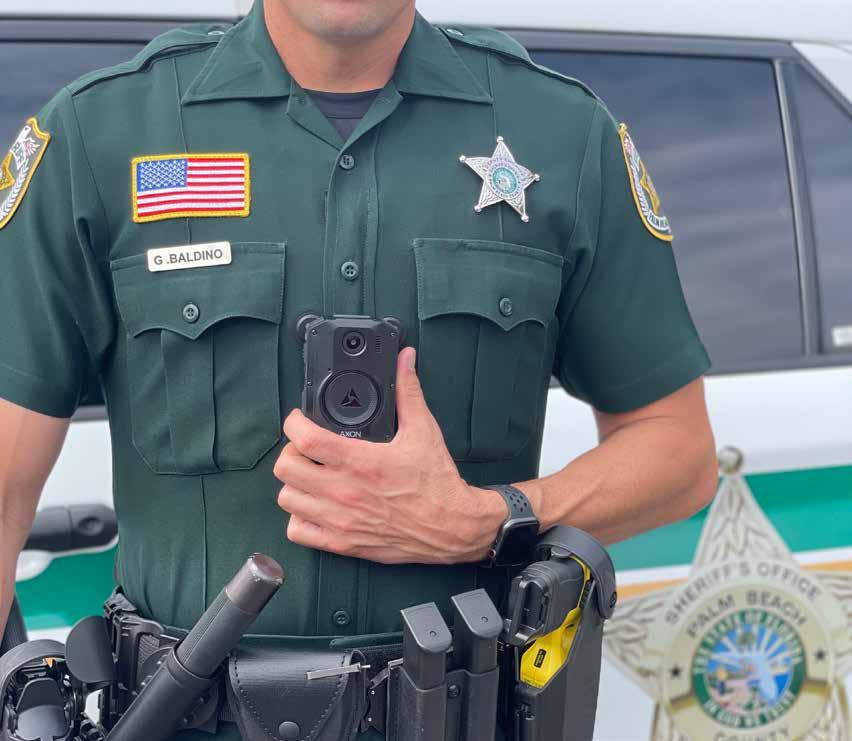

2023 INTERNAL AFFAIRS ANNUAL REPORT




A MESSAGE FROM THE SHERIFF

The Palm Beach County Sheriff’s Office is presenting to our community the 2023 Internal Affairs Annual Report. The over 4,400 dedicated and professional employees are committed to providing the highest level of professional service in order to maintain a safe community environment.
The Division of Internal Affairs has created this annual report for our citizens in an effort to be as transparent as possible. Our hope is that this report will help you understand the seriousness with which we approach your complaints and the processes we follow. This report will give you an overview of our activities in 2023 and compare similar data from previous years.
This agency is built on a foundation of trust and performance achieved through the setting of goals and the willingness to adapt. It is my hope that you will find the information in this report reassuring and helpful. I look forward to working with all members of our community. We will work together and make this a better and safer place to live, work, and visit.
Sincerely,
 Sheriff Ric Bradshaw
Sheriff Ric Bradshaw
Code of Ethics
AS A LAW
serve mankind; to safeguard lives and property; to protect the innocent against deception, the violence or disorder; and to respect the Constitutional Rights of all people to liberty, equality,
I WILL keep my private life unsullied as an example to all; maintain courageous calm in the stantly mindful personal and and the regulations nature or that is confided to me in my official capacity will be kept ever secret unless revelation is necessary in the performance of my duty.

I WILL never act officiously or permit personal feelings, prejudices, animosities or friendships to influence my decisions. With no compromise for crime and with relentless prosecution of criminals, I will enforce the law courteously and appropriately without unnecessary force or violence and never accepting gratuities.
I RECOGNIZE the badge of my office as a symbol of public faith, and I accept it as a public trust to be held so long as I am true to the ethics of police service. I will constantly strive to achieve these objectives and ideals, dedicating myself to my chosen profession...law enforcement.

MISSION STATEMENT
The Palm Beach County Sheriff’s Office is committed to protecting the public, reducing the incidence and fear of crime, and enhancing the quality of life in our community. The agency does this by doing the right thing through:
INTEGRITY
We have integrity. We are bound by the highest standards of ethical conduct. As role models, we exemplify honesty and good character, instilling community trust.
PROFESSIONALISM
We are professional. We are well-trained, competent, knowledgeable employees who demonstrate the highest level of performance, working in partnership with the community.
RESPECT
We show respect. We treat everyone with dignity, courtesy, and compassion.
FAIRNESS
We are fair. We treat employees and members of the community equitably while valuing cultural diversity. We are consistent and impartial in protecting the constitutional rights of all.

The Palm Beach County Sheriff’s Office Division of Internal Affairs is charged with the receipt, processing, and investigation of allegations made against members of the Sheriff’s Office, whether sworn or civilian.
Florida Law requires that all law enforcement and corrections agencies establish a system for the receipt, review, and investigation of allegations of employee misconduct received by the agency. All allegations received by the Palm Beach County Sheriff’s Office are reviewed by the Division of Internal Affairs then submitted to the Sheriff for initial authorization to investigate the allegation, and following the conclusion of the investigation, for final disposition.
As will be discussed later in this report, the Palm Beach County Sheriff’s Office has a responsibility to its employees and the community to identify and assist employees who display symptoms of job stress and/or performance related issues. Subsequently, the Palm Beach County Sheriff’s Office employs an Early Intervention System (EIS).
EIS captures specific data about the behavior of deputies and aids in the timely detection of problematic behaviors. The number and
type of community complaints, use of force incidents, as well as the number of vehicle accidents a deputy might be involved in, are potential factors in this assessment. These reports help identify and provide documentation of members who experience a certain frequency of involvement and are not intended as a statement of misconduct but simply a presentation of quantitative facts to be used as a management tool to identify performance issues.
This 2023 Annual Report will provide statistical information gathered from the Early Intervention System (EIS) in use by the Palm Beach County Sheriff’s Office Division of Internal Affairs, as well as an analysis of internal administrative investigations and processes.
Note: Data contained within this report reflects the constant influx of new information received on a daily basis and is applicable as of date published.
Disposition may reflect open cases from previous years.


Palm Beach County, FL
Sheriff Ric Bradshaw
Professional Compliance Bureau

In December 2017, Sheriff Bradshaw created the Professional Compliance Bureau with the intention of maintaining the highest level of service to the citizens of Palm Beach County. The Professional Compliance Bureau consists of the Division of Internal Affairs, the Training Division, and Staff Inspections.
Internal Affairs
The primary function of the Division of Internal Affairs is the receipt, processing, and investigation of complaints made against employees of the Palm Beach County Sheriff’s Office. When a complaint is received, every effort is made to ensure a thorough, timely, and fair investigation of the allegation(s) contained in the complaint. The openness of the agency in the acceptance of a complaint is a principle element of professionalism and community responsiveness. All complaints are processed and reviewed by the Division of Internal Affairs and submitted to the Sheriff of Palm Beach County for review and final disposition.
Training
The Training Division has a multitude of responsibilities and is committed to providing the best training possible to the 4,400+ employees of the Sheriff’s Office. Classroom and practical training are administered through In-Service classes, along with additional internal and external specialty classes offered to all Sworn Law Enforcement, Corrections personnel, and civilian employees as well. Our employees are committed to protecting and serving the community and upholding our guiding principles of Professionalism, Respect, Integrity, and Fairness.
The PBSO Training Division has established a reputation of excellence in the law enforcement community. We have hosted local agencies at our facilities for individualized training and international police forces as well. The PBSO Training staff is constantly striving to improve and advance their skill set by following the latest trends in law enforcement training, equipment, and tactics.

Staff Inspections
Beach County Sheriff’s Office was initially accredited by the on Florida Law Enforcement Accreditation in June 2000, successfully achieving reaccreditation every three years since. In October 2021, the Sheriff’s Office received its 7th reaccreditation with Excelsior Recognition. Excelsior Recognition is only granted to agencies that have continuously adhered to the standards over five reaccreditation cycles. The Staff Inspections/Accreditation Unit manages the process for the agency, maintaining proofs of compliance and the general orders system. Staff inspectors conduct inspections of the various functional units of the Sheriff’s Office to assure compliance with both general orders and accreditation standards. Through this process, the citizens of Palm Beach County are assured they are served by one of the most professional law enforcement agencies in the United States.
The function of the Division of Internal Affairs is to provide fact-finding assistance to the Sheriff and Executive Staff members. Internal Affairs provides a systematic, objective, and impartial investigation of complaints alleging employee misconduct.
The Division of Internal Affairs is currently commanded by a Captain, who reports to the Major of Professional Compliance who reports to the Colonel of the Department of Professional Standards who reports directly to the sheriff of Palm Beach County. The Division includes the following personnel, one (1) Lieutenant, fourteen (14) Sergeants, one (1) Office Manager, one (1) Unit Manager, one (1) Chief Security Manager, two (2) Security Technicians, three (3) Polygraph Operators, seven (8) full-time Background Investigators, one (1) part-time Background Investigator, five (5) Internal Affairs Analysts, and three (3) Internal Affairs Specialists.
In 2023, the Division of Internal Affairs was responsible for the following:
The investigators assigned to the Division of Internal Affairs have decades of combined law enforcement/investigative experience. Many have supervised investigative units within the agency.
In addition to investigating allegations of misconduct against Sheriff’s Office employees, the Division of Internal Affairs is responsible for the following:
• Agency and Building Security
• Public Records Request(s) relating to Administrative Investigations
• Pre-Employment Background Investigations
• Pre-Employment Polygraph Examinations
• Documentation Management
• Disciplinary Appeals regulated under Florida law

INVESTIGATION TYPES
It is the responsibility of PBSO to provide a systematic, objective, and impartial method of investigating complaints of inappropriate behavior or allegations of misconduct by employees. PBSO has identified the types of incidents that require review and a report by a supervisor (sergeant or civilian equivalent) or higher-ranking personnel and the method used for completing the reports. Certain incidents, because of their complexity and/or severity, will be investigated by the Division of Internal Affairs (IA).
Incident Review (IR)
A review undertaken upon receipt of a complaint. Conducted for the thorough gathering and securing of evidence and facts to discover truth and reach conclusions as to the possibility an employee has violated any rules, regulations, policies, procedures, general orders, and/or laws. Based upon this review, the Sheriff will determine the need for further investigation.
Personnel Complaint Investigation (PC)
An investigation involving gathering and securing evidence and facts to determine whether an employee has violated rules, regulations, policies, procedures, directives, and/ or general orders of the agency. PC Investigations are generally assigned to a chain-of-command supervisor for investigation, but can, at the direction of the Sheriff or designee, be investigated by the Division of Internal Affairs.
Internal Affairs Investigation (IA)
A comprehensive investigation gathering and securing evidence and facts to discover truth and reach conclusions as to whether an employee has violated any rules, regulations, policies, procedures, directives, and/or general orders of the agency.
Court Appearance Requirement (CAR)
An investigation involving gathering and securing evidence to determine whether an employee failed to appear for a required court appearance (any court related activity in which a subpoena was received). The investigating supervisor will gather all required documentation and determine, from the employee, if there was a valid reason for the missed court appearance.
Disciplinary Review Request (DRR)
An investigation involving gathering and securing evidence and facts to determine whether an employee has violated rules, regulations, policies, procedures, directives, and/ or general orders of the agency. DRRs are generally initiated by an agency supervisor after he has personally witnessed or gathered enough evidence to support a violation of any rules, regulations, policies, procedures, directives, or general orders. DRRs are completed without interviewing the involved employee.
Crash Review Board (CRB)
The Crash Review Board (CRB) reviews traffic crashes/incidents received from Risk Management involving PBSO employees and volunteers. The CRB makes a determination regarding the employee’s or volunteer’s involvement in the crash/incident to determine if it was “At Fault” or “Not at fault” with a finding requiring a majority vote.
Once the investigation has been completed, a finding will be established in accordance with Palm Beach County Sheriff’s Office General Order 222.03 Division of Internal Affairs. The following are the allowable dispositions:
EXONERATED
The alleged actions of the agency or the employee did occur, however, the actions of the agency or the employee were consistent with agency policy and Florida law.
INVESTIGATIVE FINDINGS
UNFOUNDED
The allegation is either demonstrably false or there was no credible evidence to support the complaint.
NOT SUSTAINED
There is insufficient proof to confirm or refute the allegation.
SUSTAINED
The alleged actions of the agency or the employee were supported by the preponderance of the evidence as occurring and were inconsistent with agency policy or Florida law.
CALL LOAD: INVESTIGATION VOLUME
Calls for service 1,190,830
2021 2023
Citizen complaints 664
Percent of calls resulting in complaint .05%
Percent of complaints resulting in a sustained policy violation(s) 4.96%
2022
Calls for service 1,130,253
Citizen complaints 910
Percent of calls resulting in complaint .08%
Percent of complaints resulting in a sustained policy violation(s) 4.86%
Calls for service 1,126,738
Citizen complaints 872
Percent of calls resulting in complaint .07%
Percent of complaints resulting in a sustained policy violation(s) 2.75%
*Beginning 1/1/22, in an effort to better track complaints, PBSO updated the term name from Citizen Contact to Citizen Complaints.

PBSO IMPLEMENTS BODY WORN CAMERAS
BODY-WORN CAMERAS (BWC) CAN HELP STRENGTHEN THE POLICING PROFESSION AND CAN BE USEFUL TOOLS FOR INCREASING OFFICER PROFESSIONALISM
Beginning in 2021-2022, PBSO formed a committee to research, develop, and institute a Body Worn Camera (BWC) program within PBSO. After months of planning and rigorous testing of different vendors, equipment, and scenarios, PBSO chose to implement Axon Body Worn and Axon In-Car cameras. This equipment utilizes state-of-the-art technology. The BWC will have “Live Stream Technology” which allows for real-time information to be shared with supervisory personnel during an incident.
In early 2023, the Palm Beach County Sheriff’s Office (PBSO) embarked on a significant initiative to
enhance transparency, accountability, and community trust by deploying body-worn cameras (BWCs) across its law enforcement and corrections personnel. A total of 1785 BWCs have been deployed, which includes 1,717 in Law Enforcement and 68 in Corrections. Also as part of the project; 1,100 new in-car camera systems and 1,200 new Taser 7 devices (which automatically activate the BWC upon use) were also deployed. Each member received two full days of training to obtain the knowledge and skills necessary to effectively utilize Axon’s cutting-edge technology solutions.
PBSO’s General Order 237.07 establishes guide-
lines and procedures for the use of BWC and the management, storage, retrieval, retention, and release of video recordings.
The BWC program is managed by PBSO’s Operational Technology Unit. This unit is comprised of a Law Enforcement Lieutenant, a Law Enforcement Sergeant, three Law Enforcement Deputy Sheriffs, one Corrections Deputy Sheriff, Four Provisioning Coordinators, one Special Projects Coordinator, one Clerical Specialist and one Cadet. The Operational Technology Unit operates under the command of the Bureau Director of the Records and Digital Support Services Bureau, who in return reports to the Department Director
of the Department of Operational Support.
The deployment of body-worn cameras by the Palm Beach County Sheriff’s Office has proven to be a transformative initiative, yielding numerous benefits for both law enforcement personnel and the community. From increased transparency and accountability to strengthened community relations and deputy safety, the adoption of this technology has positioned the PBSO as a leader in modern policing practices. As we continue to prioritize the safety and well-being of our community, we remain committed to leveraging innovative solutions that uphold the highest standards of professionalism, integrity, and service.

KEY HIGHLIGHTS
ENHANCED TRANSPARENCY
The deployment of body cameras has significantly enhanced transparency in law enforcement interactions. By providing an unbiased record of incidents, these cameras have empowered both law enforcement deputies and the community to hold each other accountable, fostering a culture of transparency and trust.
IMPROVED ACCOUNTABILITY
Body cameras serve as a powerful tool for accountability, enabling supervisors to review interactions between deputies and the public. This has resulted in increased accountability among law enforcement personnel, ensuring adherence to departmental policies and procedures while maintaining high ethical standards.
STRENGTHENED COMMUNITY RELATIONS
The implementation of body-worn cameras has strengthened relations between the PBSO
and the community it serves. By promoting open dialogue and transparency, these cameras have fostered greater trust and cooperation, ultimately leading to improved community-police relations.
ENHANCED OFFICER SAFETY
Body cameras not only benefit the public but also contribute to the safety of law enforcement deputies. The presence of cameras has been shown to de-escalate potentially volatile situations, providing a valuable tool for deputies to diffuse conflicts and protect themselves and others.

EVIDENCE COLLECTION AND DOCUMENTATION
Body-worn cameras serve as crucial tools for evidence collection and documentation. The footage captured by these cameras has proven invaluable in investigations, providing clear and unbiased evidence that enhances the judicial process and ensures fair and just outcomes.
PROFESSIONAL DEVELOPMENT
The utilization of body cameras has facilitated ongoing professional development among law enforcement personnel. Through the review and analysis of camera footage, deputies have been able to identify areas for improvement, leading to enhanced training initiatives and professional growth.
DISCHARGE AND DISPLAY OF FIREARMS
The most important purpose of law enforcement is the protection of human life, and the use of deadly force must be strictly limited to situations involving the protection of human life.
The policy of the Palm Beach County Sheriff’s Office dictates that all Deputies will act in good faith when using force and conform to the provisions of Florida State Statutes and may use only the amount of force reasonably necessary to affect lawful objectives. Deadly force is force which is likely to cause death or great bodily harm. Deadly force includes the discharge of firearms but may apply to the use of defensive techniques or even automobiles under some circumstances.
Beginning in December 2016, The Palm Beach County Sheriff’s Office entered into a Memorandum of Understanding (MOU) with the Florida Department of Law Enforcement (FDLE). The MOU outlines the circumstances in which the FDLE would investigate officer involved shootings involving PBSO deputies.
Per Sheriff Ric Bradshaw: “As sheriff, I am continually striving to listen to the concerns of the community,” Bradshaw said in a statement. “To bring a higher level of transparency and appearance of independent outside investigation, I decided to have FDLE investigate the criminal aspect of our deputy-involved shootings.”
Palm Beach Post Feb 4, 2017
A Deputy Sheriff may use as much force as is reasonably necessary, short of deadly force, to retain custody of an arrested person. If the arrested person resists, the Deputy Sheriff may increase the force to counter the resistance. The Deputy Sheriff has no duty to retreat as the force escalates, and if the
force should increase to the point where the arrested person threatens the Deputy Sheriff with death or serious bodily harm, the Deputy Sheriff may use deadly force.
Deputy Sheriffs who use deadly force or accidentally discharge a firearm while on or off-duty whether or not personal injury, death, or property damage occurred, shall immediately report the incident to an on-duty supervisor, who will immediately report the incident to the Sheriff and complete a Use of Force Blue Team.
The Training Division, the Division of Internal Affairs, and the Department of Legal Affairs review all incidents involving discharge of firearms. Additionally, the Division of Internal Affairs maintains the statistical data derived from reports of discharges of firearms by Palm Beach County Sheriff’s Deputies.
In cases involving a Use of Force, an internal administrative investigation is conducted parallel with a criminal investigation. All deputy-involved shootings, where there is injury or death, are presented for review by the Office of the State Attorney for the 15th Judicial Circuit. The Office of the State Attorney issues a finding on the deputy’s Use of Deadly Force, and makes a legal determination whether the case will be presented to the Grand Jury for consideration of criminal prosecution or not.
The Division of Internal Affairs is notified, but does not respond to all discharge of firearm incidents involving Palm Beach County Sheriff’s Deputies, only those involving a control of persons or use of force.
Cases where members use their firearm to destroy menacing animals or suffer an unintentional or accidental discharge are generally investigated by the member’s chain of command to determine potential violations of Florida law or Sheriff’s Office policy. If in the initial review, violations of Florida law or Sheriff’s Office policy are identified, applicable investigations are initiated.
STATISTICS FOR FIREARM DISCHARGES/DISPLAYS
Tracking Display of Firearms allows for the compiling of statistical data, monitoring of allegations regarding the careless handling of firearms, identifying Early Intervention trends and patterns, and it places PBSO into “best practice methods” as recognized by the US Department of Justice, and Police Executive Research Forum (PERF).
SUMMARY FORMAT INCIDENT LISTING
Occurred date:
January 2, 2023
Disposition: Justified
Deputies responded to a call for service regarding a disturbance. A loose pitbull emerged from under a stairwell and charged the deputy resulting in the deputy firing two rounds from his department issued handgun striking the dog. The dog survived and Animal Care and Control took custody of the dog as the owners could not be identified or located.
Occurred date:
July 19, 2023
Disposition: Justified
While attempting to locate a suspect with an active arrest warrant, a pitbull emerged from underneath a stairwell and aggressively charged a deputy. The deputy fired two rounds but missed the dog. No injuries sustained.
Occurred date:
February 19, 2023
Disposition: Open
Currently under investigation and considered confidential pursuant to FSS 119.
Occurred date:
August 24, 2023
Disposition: Open
Currently under investigation and considered confidential pursuant to FSS 119.
Occurred date:
May 1, 2023
Disposition: Open
Currently under investigation and considered confidential pursuant to FSS 119.
Occurred date:
June 25, 2023
Disposition: Justified
Deputies responded to a call for service regarding a parking complaint. Upon walking up to the residence, a dog emerged from an open door and charged at the deputy. The deputy fired one round but missed the dog. No injuries sustained.
Occurred date:
October 24, 2023
Disposition: Open
Currently under investigation and considered confidential pursuant to FSS 119.

Incident Reviews are assigned by the Sheriff and/or Division of Internal Affairs Commander. These reviews are generally conducted at the Division level by either a Watch Commander or Field Supervisor, but may also be conducted by an Internal Affairs Investigator at the discretion of the Sheriff. Upon completion, Incident Reviews are submitted to the Sheriff or his designee for review and approval. The case files are marked and identified utilizing the prefix “IR” and followed by the last two digits of the calendar year and a sequence number.
Incident Reviews often involve allegations of a minor nature against agency employees or address issues of concerns, which may affect overall agency efficiency. Incident Reviews may be assigned in order to:
• More thoroughly document facts of an incident beyond the level of detail provided within offense reports and supplements written by Deputies at the time of occurrence.
• Determine in closer detail such issues as
may be appropriate for revision of policy and procedure.
• Assess operational guidelines and effectiveness of a special operation or function.
In the event an Incident Review identifies potential policy violations, the Incident Review is upgraded to a Personnel Complaint or Internal Affairs Investigation depending upon the seriousness of the allegation.
Once a review is completed, it becomes subject to inspection and review in accordance with the provisions of Florida Public Records Law, Chapter 119. The Division of Internal Affairs maintains custody of all investigative reviews and documentary evidence. The Internal Affairs Commander is the custodian of records for the Division, and supervises the response to all requests for inspection or copies of those records made in compliance with the Florida Public Records Law, Chapter 119.
During the calendar year of 2023, the division of Internal Affairs processed five hundred thirty four (534) inquiries as Incident Reviews.
These charts reflect the allegations investigated in each Incident Review.
*Some Incident Reviews contain multiple charges therefore, these totals are higher than the total number of Incident Reviews conducted.

DISCIPLINARY REVIEW REQUESTS
Disciplinary Review Requests are initiated by an agency supervisor and approved by a commanding officer. These requests are conducted at the Division level by a Field Supervisor but may also be conducted by an Internal Affairs Investigator. Upon completion, Disciplinary Review Requests are submitted to the Sheriff for final disposition and disciplinary recommendation. The case files are marked and identified utilizing the prefix “DRR” and followed by the last two digits of the calendar year and a sequence number.
Disciplinary Review Requests involve allegations of a minor nature against agency employees. These investigations are generated when a supervisor has sufficient evidence/ information to show an agency employee has violated an agency Rule and Regulation or General Order and does not require the supervisor to interview the employee. The supervisor completes the necessary paperwork
and forwards the request to their commanding officer for approval. These requests can only be used if the discipline requested is for a verbal reprimand, remedial training counseling, or a formal written reprimand. Once discipline is approved, it becomes subject to inspection and review in accordance with the provisions of Florida Public Records Law, Chapter 119.
The Division of Internal Affairs maintains custody of all investigative reviews and documentary evidence. The Internal Affairs Commander is the custodian of records for the Division and supervises the response to all requests for inspection or copies of those records made in compliance with the Florida Public Records Law, Chapter 119.
During the calendar year of 2023, the Division of Internal Affairs processed one hundred seventy seven (177) Disciplinary Review Requests.
These charts reflect the sustained charges for DRRs
*Some DRRs contain more than one sustained charge therefore, these totals are higher than the total number of Disciplinary Review Requests.

PERSONNEL COMPLAINTS
Personnel Complaint investigations result from allegations of violations of Sheriff’s Office rules, regulations, policies and/or procedures. Personnel Complaint investigations are generally conducted at the Division level by either a Watch Commander or Field Supervisor, but may also be conducted by an Internal Affairs Investigator at the discretion of the Sheriff. All Personnel Complaint investigations are reviewed by Internal Affairs before submission to the Sheriff. The case files are assigned a case number utilizing the prefix “PC” and followed by the last two digits of the calendar year and a sequence number.
The Sheriff determines the disposition of the allegations against the focused member using the “preponderance of evidence” or “clear and convincing evidence” standard of proof. When violations of policy are substantiated, the investigation results are forwarded through the focused employee’s chain of command. The reviewing supervisors and commanders recommend corrective, re-
medial, or disciplinary action as appropriate, based upon the evidence presented and/or discovered during the course of the investigation. The Sheriff then determines the final disciplinary action. Both the focused member(s) and the complainant are notified of the final disposition in writing.
Once an investigation is completed, it becomes subject to inspection and review in accordance with the provision of the Florida Public Records Law, Chapter 119. The Division of Internal Affairs maintains custody of all investigative reviews and documentary evidence. The Internal Affairs Commander is the custodian of records for the Division and supervises the response to all requests for inspection or copies of those records made in compliance with the Florida Public Records Law, Chapter 119.
During the calendar year of 2023, the Division of Internal Affairs processed one hundred seventeen (117) Personnel Complaint Investigations.
*Totals do not include the Personnel Complaints that are active investigations to include being tolled due to criminal investigations or that have been reclassified or voided.

INTERNAL AFFAIRS INVESTIGATIONS
Internal Affairs investigations result from various complaints to include corruption, breach of civil rights, conduct involving moral turpitude, criminal misconduct, deputy involved shootings, major violations of Sheriff’s Office rules, regulations, general orders and those complaints deemed appropriate by the Sheriff. Internal Affairs investigations are conducted by the full-time staff of the Division of Internal Affairs. The case files are assigned a case number utilizing the prefix “IA” and followed by the last two digits of the calendar year and a sequence number.
propriate, based upon the evidence presented and/or discovered during the course of the investigation. The Sheriff then determines the final disciplinary action. Both the focused employee and the complainant are notified of the final disposition in writing.
The Division of Internal Affairs maintains custody of all investigative reports and any other documentation or evidence. The Internal Affairs Commander is the custodian of records for the Division and supervises the response to all requests for inspection or copies of those records made in compliance with the Florida Public Records Law, Chapter 119.
Once an investigation is completed, it becomes subject to inspection and review in accordance with the provisions of the Florida Public Records Law, Chapter 119. The Sheriff determines the disposition of the allegations against the focused member, using the “preponderance of evidence” or “clear and convincing evidence” standard of proof. When violations of policy are sustained, the investigation results are forwarded through the focused employee’s chain of command. The reviewing supervisors and commanders recommend corrective, remedial, or disciplinary action as ap-
Complaints sometimes involve allegations of a violation of criminal law against an agency member. In these cases, the Sheriff and/or the Division of Internal Affairs Commander refer the complaint information to a criminal investigator charged with the responsibility of conducting an investigation of any possible violation of criminal law. The completed criminal investigation is presented to the State Attorney for the 15th Judicial Circuit for review and if deemed necessary, prosecution. The Division of Internal Affairs conducts a parallel internal administrative investigation. The evidence documented in the criminal investigation later becomes part of the internal administrative case. In this way, all pertinent facts are included in the Internal Affairs investigation for review by the Sheriff in making a final decision on the case.
During the calendar year of 2023, the Division of Internal Affairs processed thirty two (32) Internal Affairs Investigations.

It is the policy of PBSO that discipline should be characterized as corrective rather than punitive, and that disciplinary actions are utilized as an element of an overall program to educate employees and promote proper conduct. Numerous factors are considered in determining the appropriate level of discipline to be assessed. Some of the factors involved include, but are not limited to, severity of the offense, prior violation of the
same offense or of a different offense, time intervals between offenses, effectiveness of pre or disciplinary actions, willingness to improve, overall work performance, job attitude, and disciplinary actions previously administered to other comparable personnel for similar offenses. It is further understood that certain offenses are of such serious nature that immediate dismissal upon first offense is appropriate.
*Totals do not include open investigations.
**May include terminations from Administrative Investigations initiated in previous years.
***The total number of terminations, resignations, and retirements include more than one case involving the same employee.
The most important purpose of law enforcement is the protection of human life. In order to be consistent with that purpose, the use of control, often referred to as the use of force, must be limited to situations involving the protection of human life, resistance to arrest, defense against physical assault or force necessary to perform official duties and/or self-defense or in the defense of others.
The International Association of Chiefs of Police (IACP) Use of Force Project defines force as “that amount of effort required by police to compel compliance from an unwilling subject,” and excessive use of force as “the application of an amount and/or frequency of force greater than that required to compel compliance from a willing or unwilling subject.”
The IACP Use of Force Project collects data through reports of excessive use of force from citizen or department complaints against officers that are investigated and adjudicated (sustained) and counted as excessive force incidents. This force includes physical, chemical, impact, electronic, and firearm force.
The Palm Beach County Sheriff’s Office records each use of force by members while acting in a professional capacity as a Deputy Sheriff. It is the responsibility of the Division of Internal Affairs, through the use of an advanced database, to collect a variety of data from those incidents to ensure the application of force by members of the agency is justified and within Agency policy.
In contrast to the IACP, the Palm Beach County Sheriff’s Office collects the data from all reports of force by members of the Agency. Allegations of excessive force are reviewed by the Division of Internal Affairs, with the determination of a requirement for further investigation directed by the Sheriff.
Additionally, the Palm Beach County Sheriff’s Office reports all data regarding in-custody deaths to the Florida Department of Law Enforcement (FDLE) in accordance with the Death in Custody Reporting Act (DCRA). This data is compiled quarterly and ultimately submitted to the U.S. Department of Justice.
The following pages outline the various subject matter data.

The charts below depict a comparison of the number of Use of Force incidents for Law Enforcement by district in 2021, 2022, and 2023.
*Other includes those Districts with ten or fewer Use of Force incidents and control by personnel in various Divisional assignments to include Violent Crimes, Special Investigations, Training, Court Services and Contracts. K-9 is not included as it is covered later in this report.
The charts below depict a comparison of the number of Use of Force incidents for Corrections by Section in 2021, 2022, and 2023.
*Other includes Use of Force by Corrections Personnel in Corrections Support, Standards Development and Court Security.
Hands On
Beginning January 1, 2022, categories were changed to more accurately reflect where force is being utilized.

One of the most litigated topics involving Law Enforcement is the police pursuit. When a law enforcement officer activates the emergency lights, signaling a driver to pull over, reasonable persons comply by not ignoring the officer’s show of authority. The officer must generally initiate the stop based on either probable cause or reasonable suspicion that the vehicle’s driver or a passenger is involved in activity that violates criminal or motor vehicle laws.
The primary concern of the Sheriff’s Office is public safety and the protection of human life. However, on occasion, and frequently for reasons initially unknown to the officer, the driver will not stop, but flees in an effort to evade the officer. Compelling emergency circumstances may dictate the necessity of a vehicle pursuit. Deputy Sheriffs engaging in a vehicle pursuit must always drive with due regard, consistent with “reasonable safety.”
In a split-second, a Deputy Sheriff must assess whether there is a reasonable belief that the individual driving has committed a violent felony and is such a danger to society that the individual’s escape would expose society to immediate death or danger such that warrants the use of deadly force.

VEHICLE PURSUITS
In that split-second, the Deputy Sheriff must consider all risk and take into account whether the need to engage in pursuit driving is “outweighed” by the potential risks to the public. Some of the considerations are:
The seriousness and/or dangerousness of the crime or matter warranting police involvement; Pedestrian and vehicular traffic patterns and volume; Time of day; Road conditions, weather conditions, lighting, and visibility; Terrain (curves, hills, building, etc.); The types of roadway and speeds involved; Likely effectiveness or ineffectiveness of emergency lights and siren; The capability and limitation of police equipment; The Deputy Sheriff’s own skills in emergency driving; The familiarity of the area by the Deputy Sheriffs involved; The quality of radio communications; Alternate or safer methods of problem solving; Any other factor, which increases or decreases risk.
The Division of Internal Affairs maintains the statistical data derived from pursuits by Palm Beach County Sheriff’s Deputies. Each pursuit is initially reviewed by the involved Deputies’ supervisory chain and further reviewed and evaluated by the Training Division and the Division of Internal Affairs staff.

TOTAL:
TOTAL:
TOTAL: 13 (4 INVOLVED CRASHES)

A fundamental right guaranteed by the Constitution of the United States to all who live in this Nation is equal protection under the law. Along with this right to equal protection is the fundamental right to be free from unreasonable searches and seizures by government agents. Citizens are free to walk and drive our streets, highways, and other public places without police interference so long as they obey the law. They also are entitled to be free from crime, and from the depredations of criminals, and to drive and walk our public ways safe from the actions of reckless and careless drivers.
The PBSO is charged with protecting these rights for all citizens of Palm Beach County,
regardless of race, color, religion, sex, national origin, age, disability, familial status, marital status or sexual orientation.
Because of the nature of our business, employees are required to be observant, to identify unusual occurrences and law violations, and to act upon them. It is this proactive enforcement that keeps our citizens free from crime, our streets and highways safe to drive upon, and that detects and apprehends criminals. It is the mission of the PBSO to accomplish this in a way that respects the dignity of all persons and yet sends a strong deterrent message to actual and potential lawbreakers that if they break the law, they are likely to encounter the police.
POLICE CANINE AND THE USE OF FORCE
When discussing the use of force by law enforcement, frequently overlooked is the police canine; however, the police canine is an instrumentality of force, much like a baton or pepper spray and the rules that apply to police use of force generally apply to the use of the police canine.
The use of the police canine even to inflict serious injury may be reasonable and necessary based on the circumstances. As in all use of force by law enforcement, the issue will be decided through the reasonableness: was the force used proportionate to the apparent need to apprehend criminals, prevent escape, or protect persons.

As applied to the police canine, the reasonableness standard means a canine bite is justifiable and lawful force if the threat to the officers or the public is serious. In the case of canines, the need for force must be sufficient to justify the injury of a dog bite. A dog’s bite is no different from a laceration inflicted by a baton, but generally less lethal than a gunshot. It is the need for force, not the injury inflicted, that determines whether the force used is justifiable.
There are many decisions from the U.S. Supreme Court, as they relate to the use of force and consequently to that force demonstrated by a police canine. As in other uses of force, application of the three-part test decided in Graham v Connor justifies a canine deployment:
• The severity of the crime at issue.
• Whether the suspect poses an immediate threat to the safety of law enforcement officers or others.
• Whether the suspect is actively resisting arrest or attempting to evade arrest by flight.
• And the totality of the circumstances.
Palm Beach County Sheriff’s Office policy strictly regulates the control of Sheriff’s canines, consistent with case law, for canine usage and deployment.
The Division of Internal Affairs maintains the statistical data derived from canine usage by Palm Beach County Sheriff’s Deputies. Each usage is initially reviewed by the involved Deputies’ supervisory chain and further reviewed and evaluated by the Division of Internal Affairs staff.
For 2023, PBSO Canine Deputies deployed their canines to apprehend suspects 703 times of which only 71 of the deployments resulted in actual bites to the suspect which is a bite ratio of 10.10%, well within the national acceptable average.
TOTAL K9 APPREHENSIONS: BITE RATIO 2023
With Bite
58 With Bite
With Bite
 71
632 Wit hout Bite
2021
41
568 Wit hout Bite
2022
592 Wit hout Bite
71
632 Wit hout Bite
2021
41
568 Wit hout Bite
2022
592 Wit hout Bite
EARLY INTERVENTION SYSTEM (EIS)
The Palm Beach County Sheriff’s Office has a responsibility to its employees and the community to identify and assist employees who display symptoms of job stress and/or performance problems.
Since the 1980’s, the Palm Beach County Sheriff’s Office has employed a mechanism to track and monitor such issues. In the early days, it was referred to as an Early Warning System or EWS. This term has given way to Early Intervention System or EIS.
The EIS system captures specific pieces of information about the behavior of Deputies to help identify problematic behaviors early. Examples could include the number and type of community complaints, the number and type of use of control incidents, also referred to as use of force, and the number of vehicle accidents a deputy might be involved in.
The Palm Beach County Sheriff’s Office Division of Internal Affairs produces reports for Executive Staff and Middle Management level supervision to provide information for review of Personnel Complaints and use of control issues. The reports help identify and provide documentation of members who experience a certain frequency of involvement in these types of complaints and reports.
Alerts are generated based upon a daily review assessing both a specified period of time and frequency, often referred to as thresholds, on the following actions of officers: complaints received, control of persons, canine usage, vehicle pursuits, and discharge of firearms. These actions are categorized individually and each has its own threshold.
As an example, following a vehicle pursuit, the primary pursuing officer’s supervisor will complete and submit, through the chain-ofcommand, required documentation capturing various criteria surrounding the pursuit. Upon final review, approval and submission into a database by the Division of Internal Affairs, the EIS process is initiated for that officer and the assessment period begins. As the twelve (12) months pass, if the officer is not involved as the primary officer in another vehicle pursuit, the process concludes without any alerts.
Conversely, if the officer is involved as the primary pursuing officer in five (5) more vehicle pursuits within those twelve (12) months, the alert is automatically generated and the officer’s command is directed to complete a review of all five (5) vehicle pursuits outlined in the alert.
The thresholds for each category and a sample alert can be found on the following pages.

The following are the established thresholds, time periods and frequencies for each category. On the following page is a sample alert.
EIS I Report- Complaints (Formal I.A. and P.C.)
Deputies with five (5) or more complaints within the previous twenty-four (24) months.
EIS II Report- Use of Force
Deputies involved in five (5) or more control of person incidents for the previous twelve (12) months. (Excluding canine usage and firearm discharges).
EIS III Report – Canine Usage
A bite record of each canine, categorized by the deputy as the handler, will be reviewed quarterly.
EIS IV Report – Discharge of Firearms
Deputies involved in three (3) or more firearm discharge incidents in the previous sixty (60) months.
EIS V Report – Vehicle Pursuits
Deputies involved in five (5) or more vehicle pursuit incidents as the initiating deputy for the previous twelve (12) months.
All thresholds are on a rolling calendar time period so that a deputy who has received an Early Intervention for one of these dimensions has been reviewed and counseled with a Supervisor to discuss policies, training and any potential concerns. This report however reflects a specific time period running from January 1, 2023, to December 31, 2023. It is important to remember these reports are not intended as a statement of misconduct, but are simply a presentation of quantitative facts to be used as a management tool to identify performance issues that infringe on the level of service expected of the Palm Beach County Sheriff’s Office by the community and could be counterproductive to professional careers.

EARLY INTERVENTION USE OF FORCE
STATISTICAL SUMMARY
ANSWER: 26
14 Law Enforcement
12 Correct ions
Number of employees with five (5) or more use of force reports for the year preceding December 31, 2023.
Total: 26

ANSWER: 234
111 Law Enforcement
123
Correct ions
Number of employees who are new to the current EIS II Report.
Total: 14
Total number of use of force reports associated with the employees reported in the above section.
Total: 234
ANSWER: 14
4 Law Enforcement
10
Correct ions

Number of employees on the previous EIS II Report who are not on the current Report.
Total: 26
ANSWER: 26
ANSWER: 12
2 Correct ions
12 Law Enforcement
14 Correct ions
Number of employees who are repeaters on the current EIS II Report.
Total: 12
10 Law Enforcement






